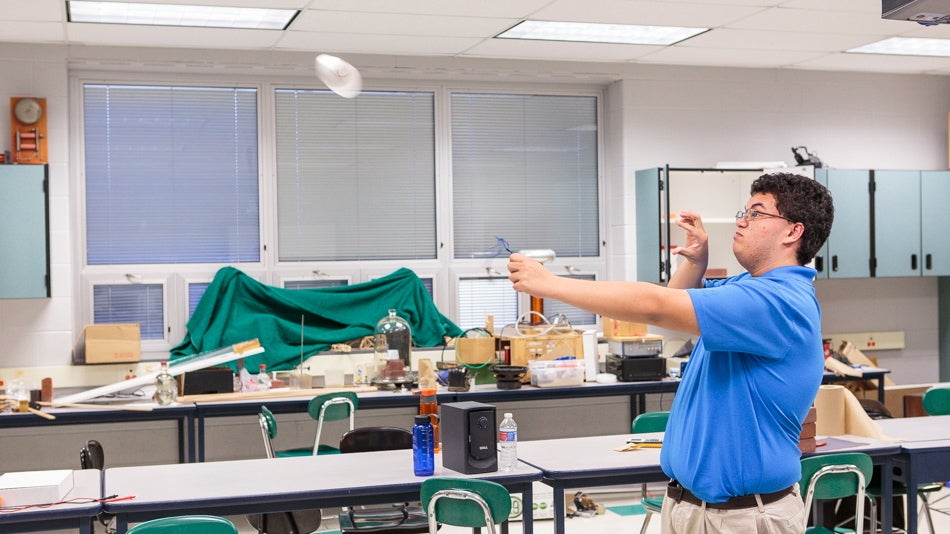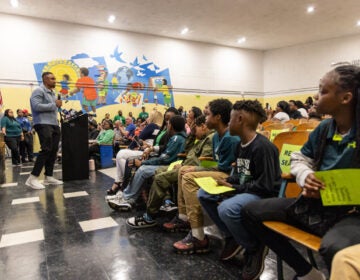High school team from Phoenixville to represent USA at Physics World Cup
Listen
Physics team member Andrew Mangabat practices the 'Magnus Glider' challenge for IYPT 2015. (Jack Dugan/WHYY)
The United States hasn’t participated in the Physics World Cup in eight years, but students from Phoenixville High School in Chester County are about to change that.
Five seniors are headed to Thailand this summer to compete against more than 30 other countries, including Brazil, Iran and New Zealand.
Teams must solve 17 open-ended problems, like why coffee sloshes when you walk and why clothes appear darker when they get wet.
“They are not paper-and-pencil problems,” said Jay Jennings, Phoenixville physics teacher. “Students have to research past experiments, past theory and then design experiments that allow them to understand and hopefully contribute to the scientific understanding of them.”
Senior Brian Tu fills a glass container with Rolos. He’s studying conical frustums — cones with their tops cut off–to see how many he can fill within a specific amount of space.
“This is actually something that people experience in everyday life, filling up containers with particles of pretty much the same size,” he said. “What I’m really looking at is how their shape matters in packing.”
He picked that shape because it’s commonly used for things like cups and ice cream containers and is examining different packing methods.
Phoenixville’s participation all started with a tweet. After physics teacher Jay Jennings tweeted a physics-related joke, Phoenixville High School was invited to participate in the International Young Physicists’ Tournament, better known as the Physics World Cup.
“It was really a very complete tournament,” he said. “It gets students involved in applying their scientific knowledge and going much deeper than what we’re normally able to do in the physics classroom.”
Jennings approached his students at the beginning of the school year about reviving the USA’s participation, after he learned the schools that used to organize America’s participation stopped eight years ago and instead created a U.S.-based tournament.
“We decided as a group that we wanted to change the situation where the U.S. wasn’t participating,” he said. “If we want to be at the forefront of science and technology, we have to engage with science and technology and we also have to do it with the other countries.”
The physics teacher says the five seniors selected are universally interested in science and engineering careers.
“I plan to attend college and major in mechanical engineering,” said senior Karl Sewick, whose project analyzes light and how it works, a topic normally beyond the scope of a high school classroom. “So, I feel really good about myself understanding all this stuff and it makes me happy and excited to see how I handle college.”
Each country may have five team members, and many countries have all-star teams created from national selection tournaments. Jennings selected these five from the 30 members of Phoenixville’s physics club. He decided students from the same school would be more manageable in the first year of reviving America’s presence. He hopes to expand participation to regional and national levels in future years.
Senior David Nascari’s project is analyzing what happens to a candle’s plume of smoke as it descends.
“When I do this, I not only get a better understanding even if I’m wrong. It just helps me learn the thing better being wrong, than if I had been doing a homework problem in class and got it right,” he said.
Senior John Lukowski , who is considering a robotics engineering major, likes brainstorming with his teammates.
“The best would be working with all the other team members and collaborating on each of the problems,” he said.
His moving brush project is a vibrating surface with a brush on top of it.
“Because of my love for science, I found that applying it in this way could really help the scientific community, and it’s helping me to learn a whole lot about research and experimentation,” he said.
Andrew Mangabat, also a senior, is building a hovercraft. He blows up a balloon and places it over a bottle cap that is glued to a CD.
“When the balloon expels air it creates a little layer of air for the CD to float,” he said.
Andrew is looking forward to representing the U.S. and to meet students from around the world.
“I’m kind of looking forward to see how other countries compare to us and to talk to the other physics students about what they do different than what we do,” said the senior.
The team is getting help from Ursinus College, MIT and University of the Sciences faculty.
The main part of the tournament is “physics fights,” where teams discuss and debate their work before a panel of expert judges. Students and faculty from University of the Sciences are hosting practice skirmishes to help the high schoolers with their presentation and defense skills.
The week-long tournament is from June 27 to July 4 in Korat, Thailand.
“To me, it’s an amazing opportunity, not just from the science end of it where they get to do research for the most part at a graduate student level while they’re still in high school,” Jennings says. “But they also get to interact with all these other people who are interested in science.”
The team is halfway to their fundraising goal of $30,000. More info can be found here.
WHYY is your source for fact-based, in-depth journalism and information. As a nonprofit organization, we rely on financial support from readers like you. Please give today.




